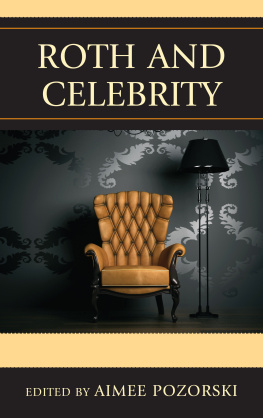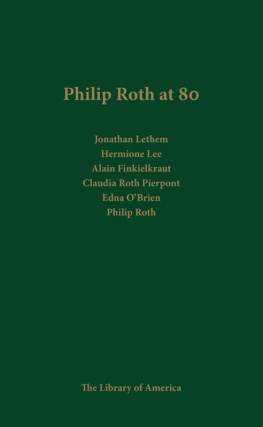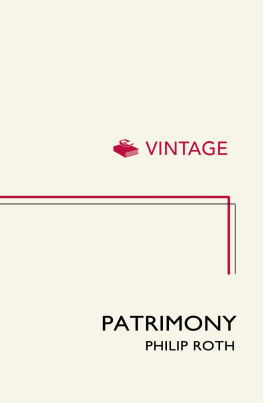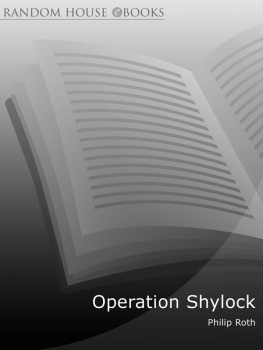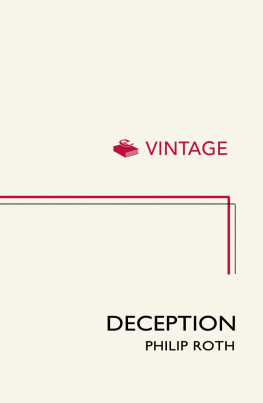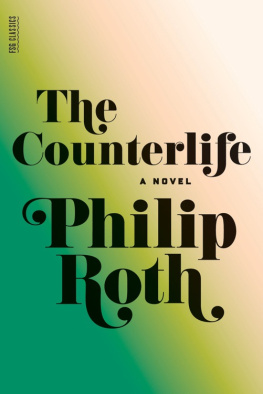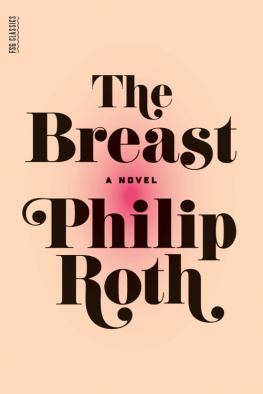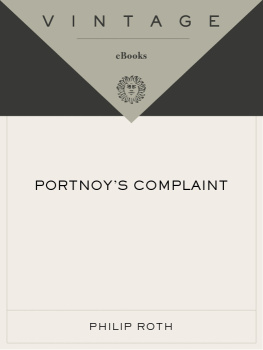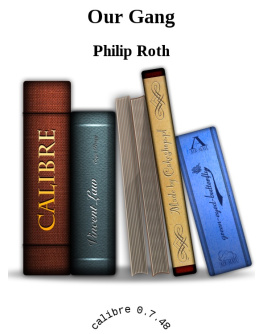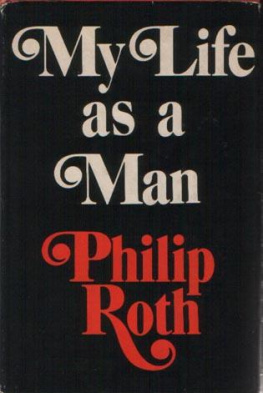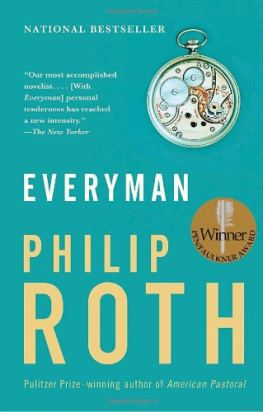Acknowledgments
Acknowledgments Acknowledgments
I would like to thank, first and foremost, the contributors to this collection. It should go without saying that it would not exist without thembut I would very much like to say it anyway. This collection would not exist without the ten stellar scholars who have contributed original work as well as expended a great deal of time and patience working with me over the past eighteen months. Thank you to James Bloom, Derek Parker Royal, and Debra Shostak who were game when I first thought to propose a panel on Roth and Celebrity for the 2011 convention of the Modern Language Association in Los Angeles, California. Thank you to Michael Sisskin of Lexington Books who commissioned the work to be considered for publication, and to Mark Shechner and Ira Nadel who each said, in their own turn, Finalize a contract, and I am in. Thank you to the other exemplary scholars who came on board on the strength of the original cast: Miriam Jaffe-Foger, Matthew Shipe, Maggie McKinley, Brett Ashley Kaplan, and Nigel Rodenhurst. At that moment we all signed on, there was nothing guaranteeing success except for an extraordinary amount of trust and goodwill.
Thank you to Justin Race, Eric Wrona, and Sabah Ghulamali at Lexington and Robert Westfall at Rowman and Littlefield who worked tirelessly to see this collection into print. Thank you to Jessica Henderson at the Wylie Agency for helping to secure permission to print an unpublished letter that Philip Roth wrote to Ted Solotaroff in 1974. And thank you to the officers of the Philip Roth Society who support our work in all ways imaginable: Jessica Rabin, Christopher Gonzalez, David Brauner, David Gooblar, and Richard Sheehan.
This is a characteristic venture of the Philip Roth Society in that many of the members came together not only to communicate their ideas but also to support the ideas of others. In these pages, the more veteran writers prop up the emergent scholars. I am incredibly proud to say that the authors of these essays range in career trajectory from tenured, full professor and named chair to post-doctoral candidate in English. The Roth Society is structured on a system of mentoring and support, and that is on full display in these pages.
Thank you to Dean Susan Pease and the Carol A. Ammon School of Arts and Sciences for supporting this work with the three unmatchable gifts of money, time, and encouragement. Thank you to the Central Connecticut State University Department of English and all my colleagues there who make my life so rewarding.
Thank you to Ann Marie White. Perhaps only she will know why.
Thank you to Philip M. Roth. Perhaps everyone except him will know why.
And no venture is complete without thanking my familythose mentioned at the end of this list are only mentioned here because they are the last people I think of at the end of the day, and the first people I think of at the beginning of the next: Thank you to Jason B. Jones and Eliot Krzysztof Jones who understand that although I am only a celebrity in my own mind, I am still worth keeping around most of the time. Their patience, support, and pride in my work are only surpassed by the joy they bring at every turn.
Aimee Pozorski
Roth and Celebrity
Aimee Pozorski 1 Aimee Pozorski An Introduction An Introduction
In July of 2011, I found myself in the uncanny position of making arrangements on the phone with one Mr. Philip Roth. He had received my name and number from a mutual acquaintance and wondered if I would be available that weekend to help shelve his books. It seems heand his century-old Connecticut farmhousewere not exempt from natures wrath the year before. A fellow resident of Connecticut, I immediately understood the kind of damage that the record snow and ice from the previous winter had caused to his home. And now it was time to rebuild. For help, he unwittingly asked the current president of the Philip Roth Societyone who, like Nathan Zuckerman, would imagine herself as starring in her own Bildungsroman as she arrived at his hideaway to meet the great man (3).
If you were to say that this sounds like a moment from a Roth novel, you would be right: The first pages of The Ghost Writer from 1979 in which Nathan Zuckerman introduces himself to his hero have been on my mind since that summer day. I have seen myself in that novel scene by scenefrom the very moment I arrived at the clapboard farmhouse... at the end of an unpaved road (3).
On the day I was supposed to arrive, I found myself slightly disoriented. The roads in this part of Connecticut are narrow and curvy; I was supposed to look for a copse of trees as a landmark, but to my eye I could see nothing else. Everywhere I looked I saw a cluster of trees and a well kept home. How could I be sure I had found the right one? True to my own character, I stopped one of his neighborsfrom what I could tell, she was a distance runner. She knew the house but not the man who lives there. She wanted to know why I had come. I explained about the books, and she nodded, half believing. Finally she asked, as I was turning away, with a tone half conspiratorial and half sincere: Are you going to blog about it?
In fact, the thought had never occurred to menot because I didnt think Id have anything to say. But rather because I didnt imagine making public my experience, especially because such a topic as meeting Philip Roth seemed off limits. I had heard as often as the next fan how very private Mr. Roth is; how uncomfortably he wears the mantle of celebrity. Further, I wondered, how does one write about the author who had inspired her own work? How does one narrate the experience of meeting a literary legend when he had already done it so well in his own books? I swallowed hard and got into the car. The next words I would speak would be to the so-called recluse himself. I would have to extend my arm and open my hand and introduce myself as the person he called to shelve books. The rest Id save for another timethe published book, the Roth Society, the Philip Roth Studies journal, all of it. I was there for the day to shelve books. I would do as I was told.
It should have come as no surprise to me that the process of replacing hundreds of books on Mr. Roths shelves was extremely well orchestrated. I worked from a list of numbered boxes as well as colored printouts of photographs of the shelves before the books came down. (If only I had thought of such a system, I reflected, during all of those moves in my twenties with all of those books!) Every day that has gone by since, I chastise myself for not asking for those photographs of every single book in Mr. Roths library, lined up neatly on its shelf. The books, I thought, would reveal so much about the elusive author. It was as if, I thought, having access to them would give me access to his thoughts. Not so, it turns out. Not so.
But I do think it is fair to say the sheer number of the booksfiction, poetry, non-fictionand the sophistication of the titles can tell us something we already knew: That Philip Roth is a writers writer. He devours and cherishes the books of others as much as we do his. I remember feeling particularly validated when I reordered all of the Hannah Arendt on his shelves, as reading her work on revolution gave me a new appreciation of Roths many passages about the founding of the United States. A similar feeling came over me when I finally encountered the Virginia Woolf novels at the end of the fiction listas her use of free indirect discourse seems to have influenced Roths own. And just before that sense of understanding, I felt a quiet sadness as I placed every one of John Updikes books in their placeso many of them: all symbols of both likeness and friendship shared between the two authors.
In fact, if I were a better scholar, a better writer in search of knowledge about her imagined mentor, I would have done as Nathan Zuckerman thirty years before:

